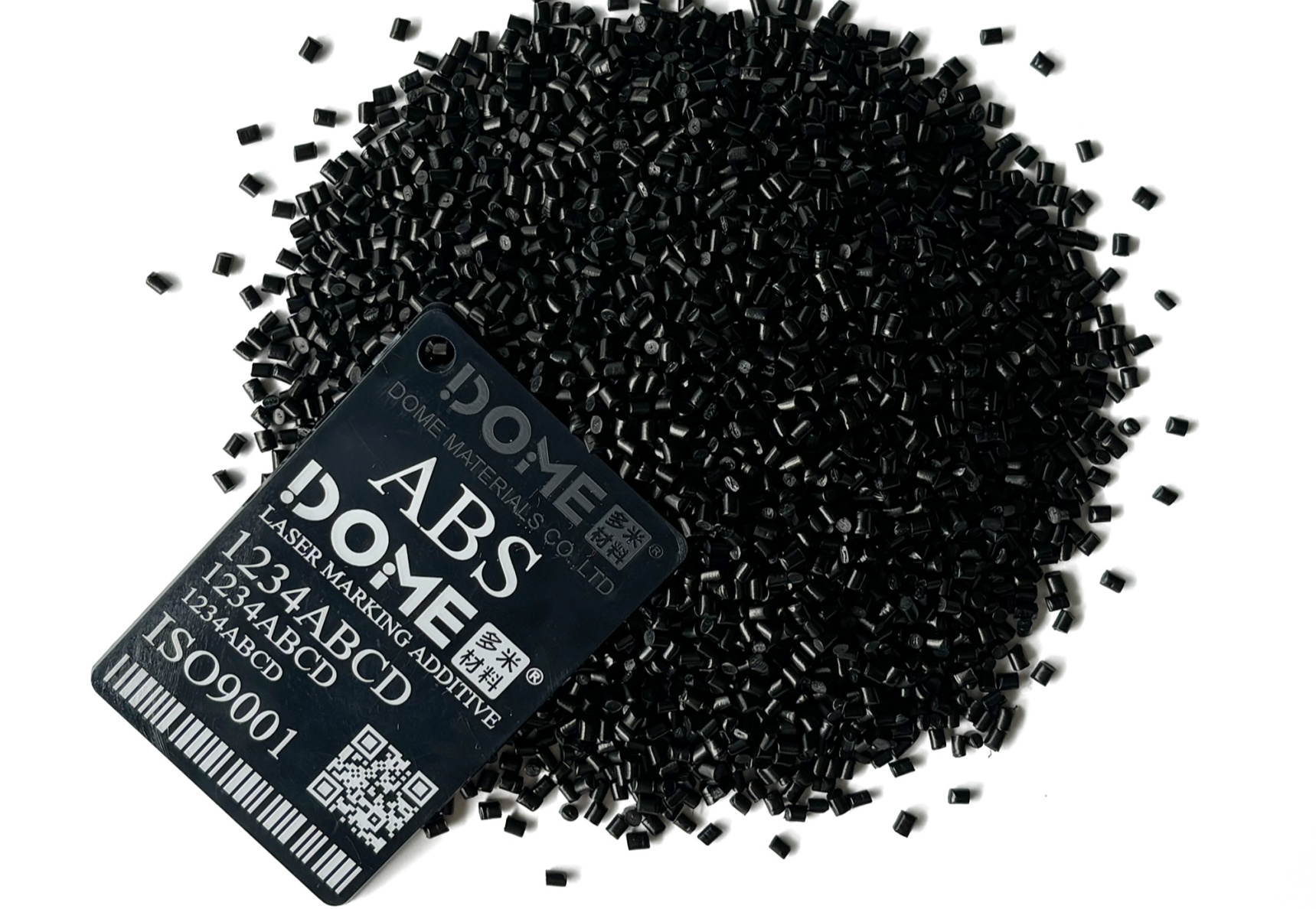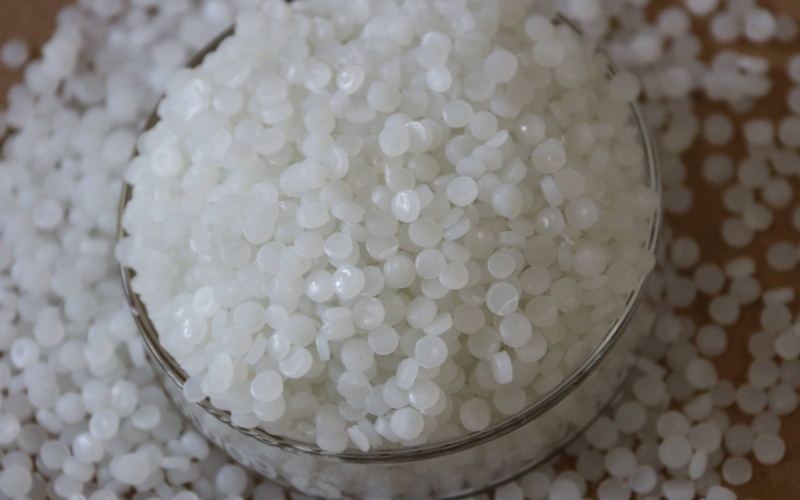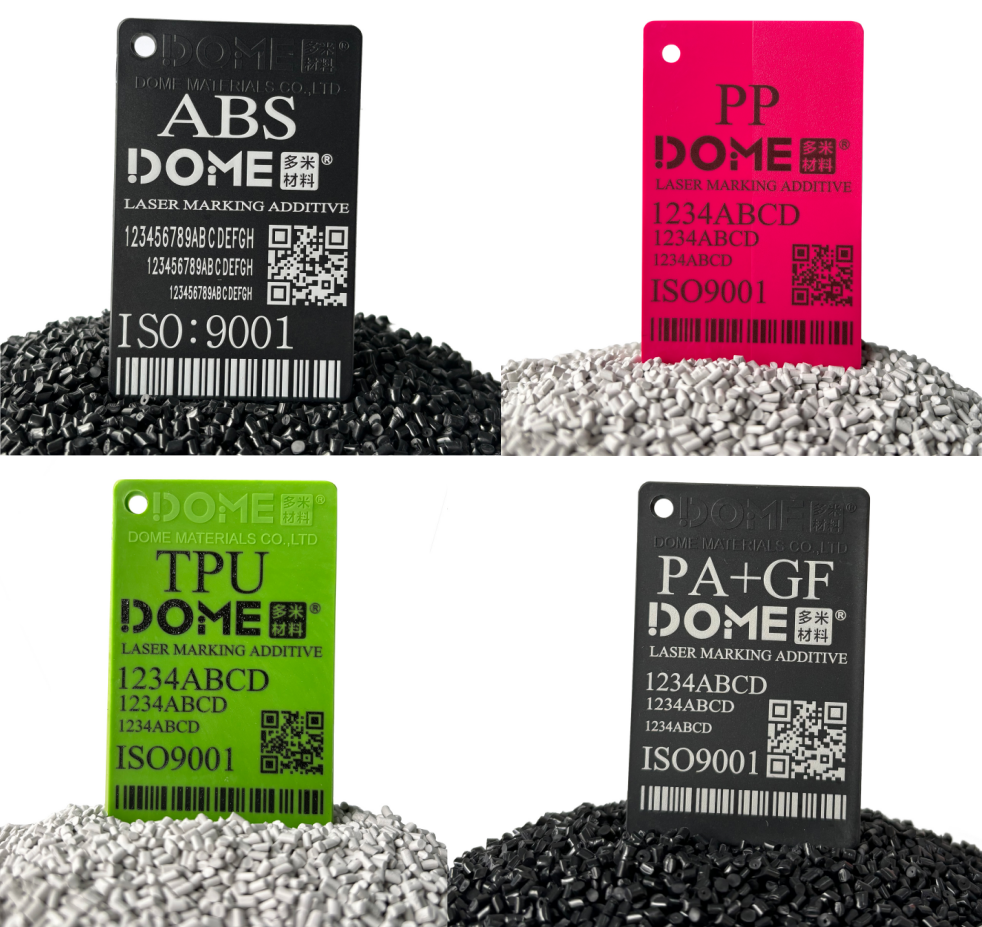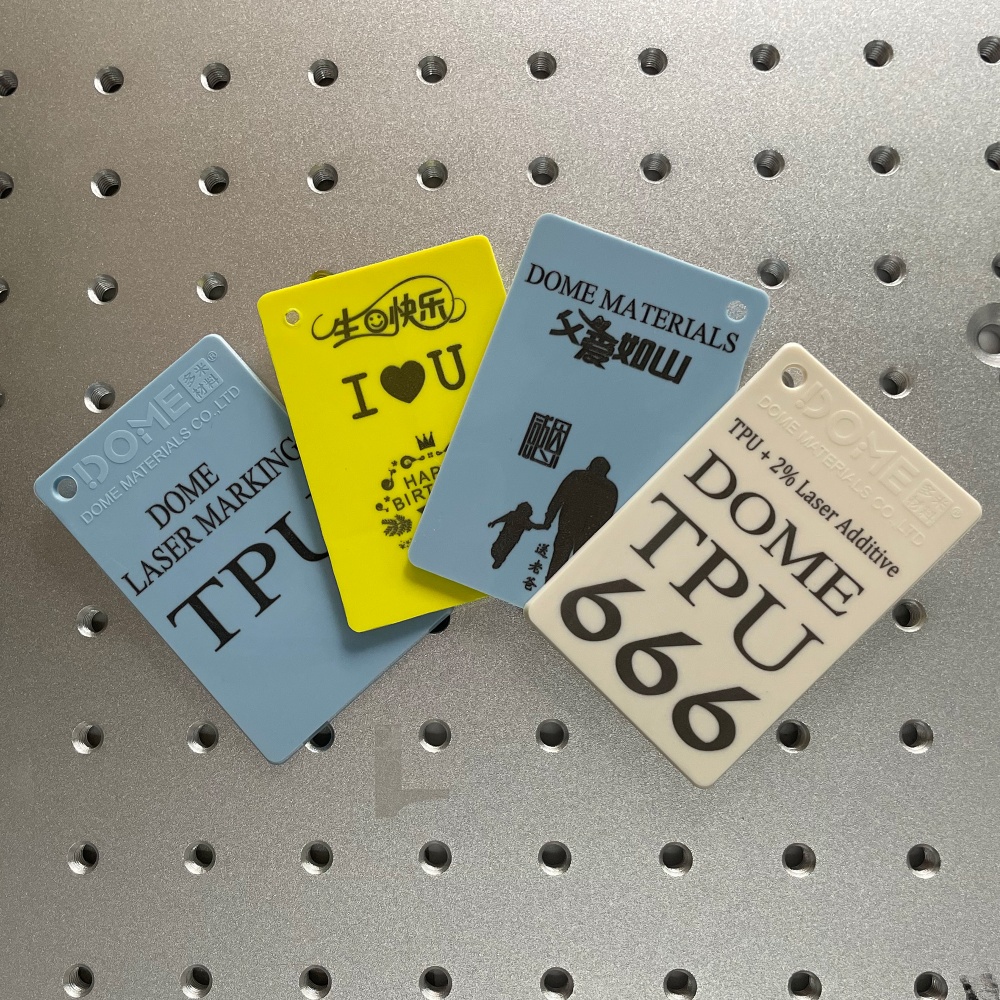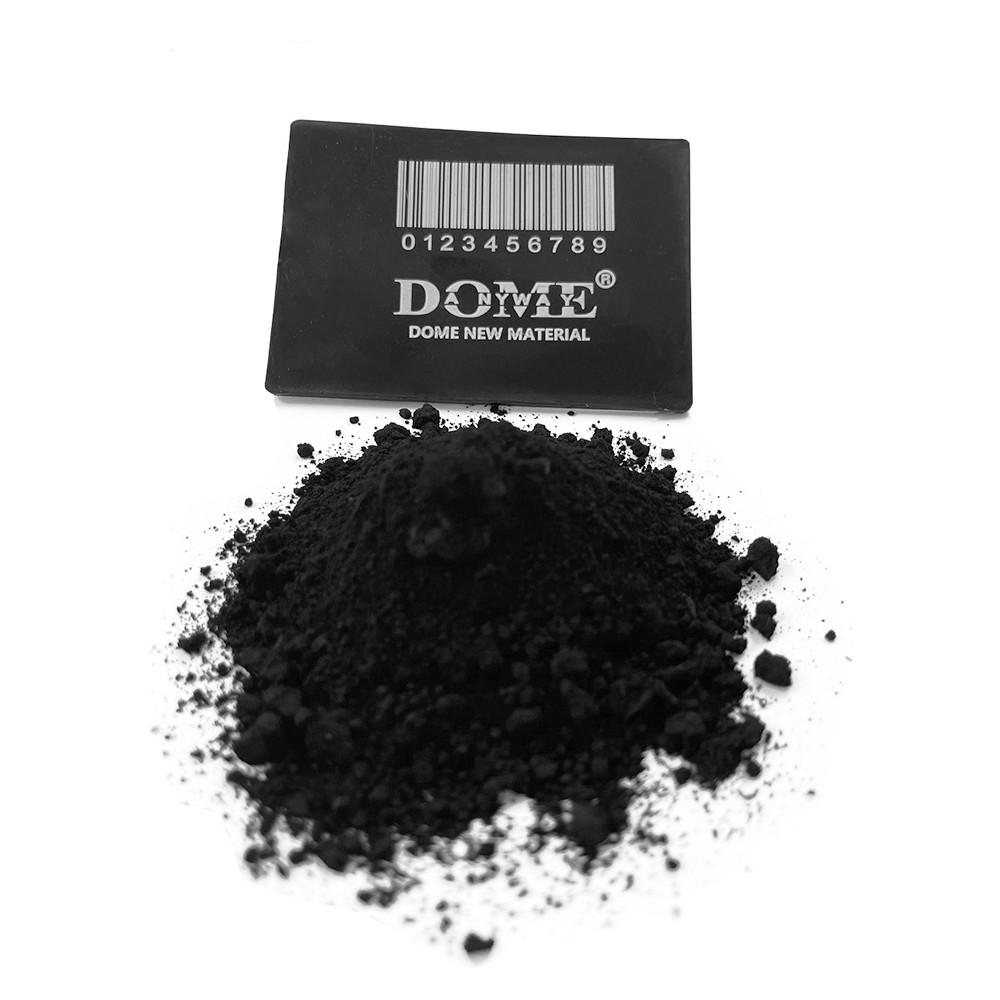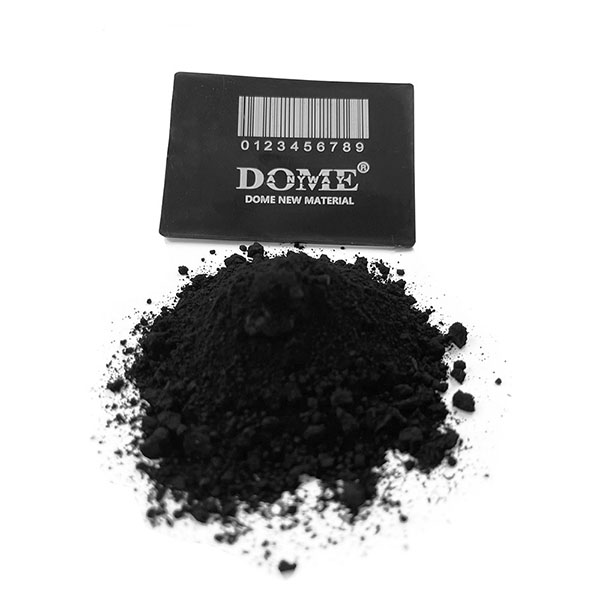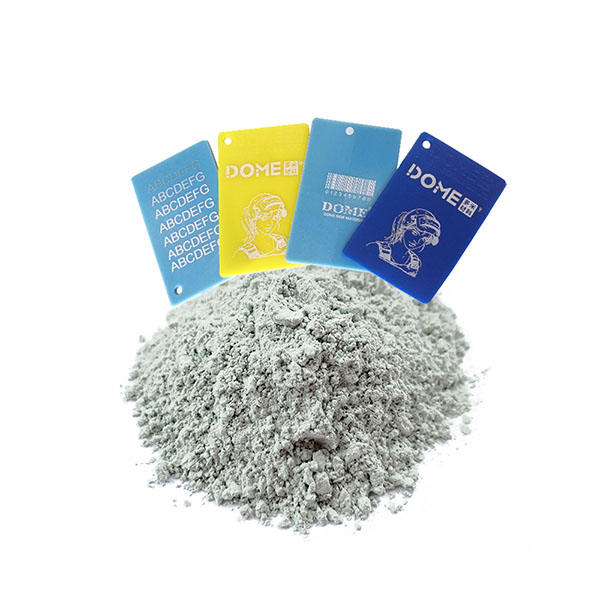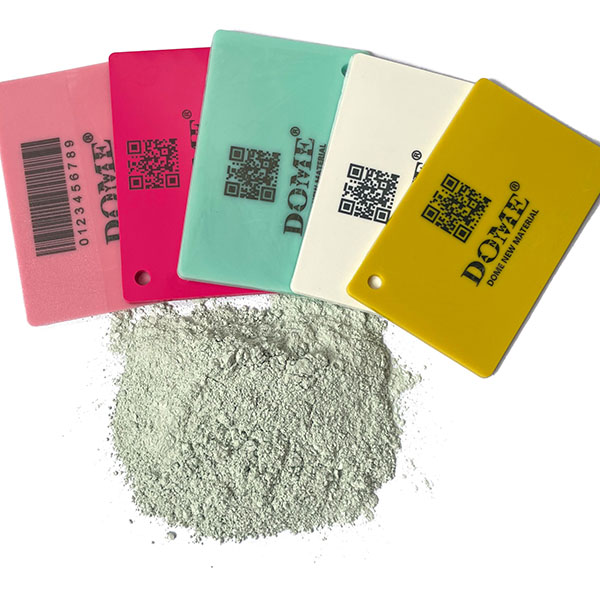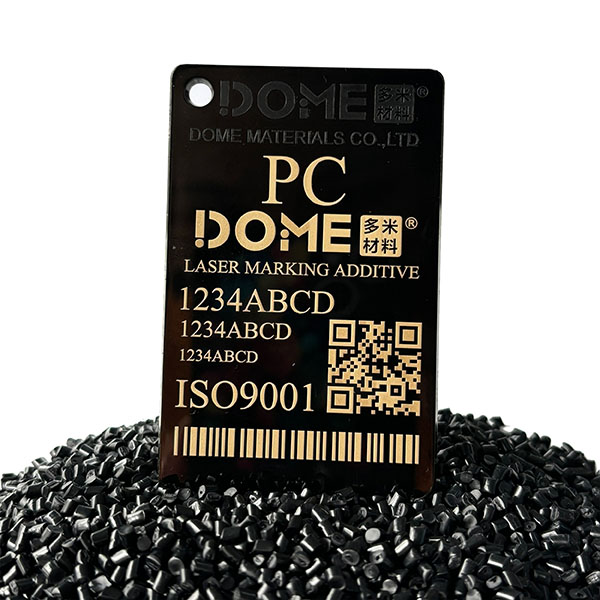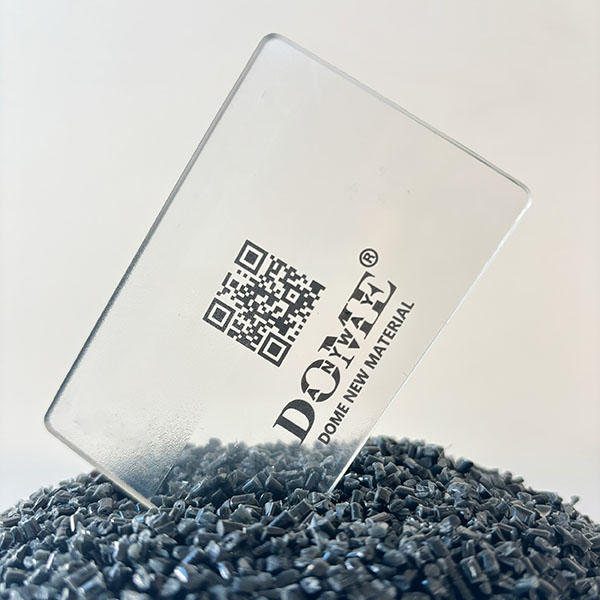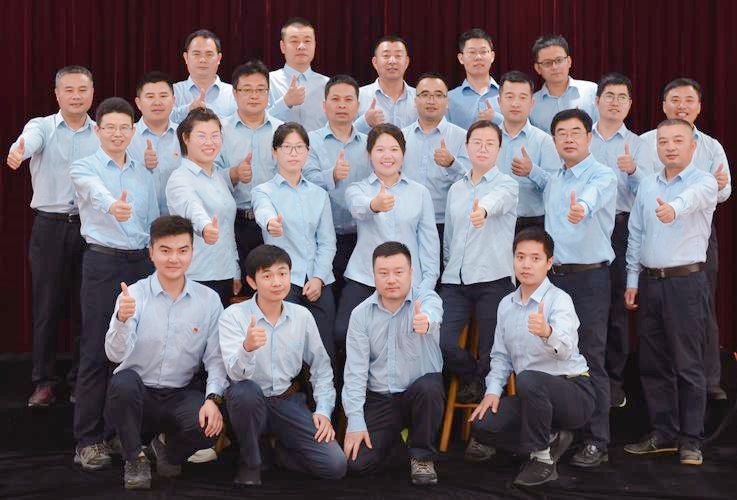Basic Composition and Principles of Laser Marking Additives

Analysis of Main Components
Laser marking additives are primarily composed of laser additives, laser powders, plastic substrates, and dispersants. Laser additives enhance the material’s ability to absorb laser energy, making them one of the key factors in improving marking performance. Laser powders can mix thoroughly with materials like plastics, making the material more responsive to laser irradiation and producing clearer markings, thereby optimizing marking quality. Similarly, laser engraving powders play an important role by making plastic materials more suitable for laser marking, thus improving the clarity of laser markings. These various components work together to form laser marking additives, a specialized chemical substance that lays the foundation for their effectiveness in laser marking processes.
Revealing the Working Principles
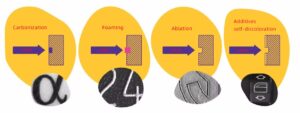
The core principle of laser marking additives lies in their ability to absorb and convert laser energy. When a laser irradiates a material containing these additives, the components in the additive first absorb the laser energy and convert it into heat. For materials like plastics, this heat energy triggers corresponding physical or chemical changes.
Carbonization Effect: In some materials, carbonization occurs in the laser-irradiated area. The additive facilitates the burning and carbonization of surrounding resins, leaving black markings. This is commonly used in “white-to-black” marking techniques on light-colored substrates.
Foaming Reaction: In other cases, the additive generates heat that causes the resin to degrade, producing gases that form numerous tiny bubbles in the substrate. This results in light-colored or white markings, suitable for dark or black substrates, known as the “black-to-white” marking technique.
Evaporation or Melting: Some materials absorb high amounts of heat, leading to evaporation or melting, which creates an engraving effect. Alternatively, the surface coating of the material absorbs the laser energy and is removed, producing an erosion effect.
Through this series of physical or chemical changes, clear and high-quality markings are formed on the material’s surface. This significantly enhances the effectiveness of laser marking, improving both the quality and efficiency of the process.
The Performance of Laser Marking Additives in Enhancing Marking Quality

Improving Marking Clarity
Marking clarity is critical in laser marking processes, and laser marking additives play a significant role in this regard. For materials such as plastics and silicone, which are typically difficult to mark, additives help achieve high-definition markings.
For instance, in the marking of plastic products, many plastics have limited laser absorption and reaction capabilities, often resulting in blurry or unclear markings when marked directly. However, with the addition of laser marking additives, the situation improves significantly. Common engineering plastics, when mixed with additives such as laser powders or engraving powders, can better absorb laser energy during irradiation. These additives rapidly convert laser energy into heat, triggering physical or chemical changes on the plastic surface.
In “white-to-black” marking techniques, the additives facilitate the burning and carbonization of surrounding resins, leaving behind clear black markings. Conversely, in “black-to-white” marking techniques, the heat generated by the additives causes the resin to degrade, releasing gases that form numerous tiny bubbles in the substrate, resulting in clear, light-colored, or white markings.
Similarly, in the marking of silicone products, the soft nature of silicone and its poor responsiveness to lasers often lead to issues such as blurry markings or fading over time. However, with the use of laser marking additives, silicone can respond better to laser irradiation, displaying durable and clear markings. Whether for product identification, parameters, or patterns, the information can be presented with high quality, facilitating subsequent operations such as recognition or scanning. This greatly enhances marking quality, transforming markings from barely discernible to highly visible, meeting various production and usage requirements.
Enhancing Sensitivity to Lasers
Laser marking additives also enhance a material’s sensitivity to lasers, which is crucial for improving marking quality.
The higher a material’s sensitivity to lasers, the better it can absorb laser energy during the marking process, resulting in superior quality in terms of detail and color presentation. Some materials, due to their weak absorption of laser energy, fail to undergo the necessary changes under laser irradiation, leading to suboptimal marking effects, such as blurry lines or low color contrast.
When laser marking additives are introduced, the components in the additives alter the material’s laser absorption properties, enabling it to absorb laser energy more efficiently. For example, in the production of electronic component casings that require high-precision marking, plastic materials with appropriate laser marking additives allow lasers to “sculpt” intricate patterns and text on the surface with precision. Information such as serial numbers and batch codes can be marked with sharp edges, smooth lines, and vibrant, accurate colors, achieving high-quality marking results.
Similarly, in the marking of automotive interior button switches, the enhanced laser sensitivity provided by the additives ensures that the markings are clear and prominent. Regardless of lighting conditions or prolonged use and wear, the markings maintain excellent visual quality. This not only improves the overall product quality and aesthetics but also highlights the critical role of laser marking additives in enhancing marking quality.
The Role of Laser Marking Additives in Promoting Marking Efficiency

Principles of Accelerating Marking Speed
The ability of laser marking additives to accelerate marking speed lies in their unique properties and mechanisms of action. Key components such as laser additives, laser powders, and engraving powders exhibit excellent laser energy absorption capabilities. When exposed to laser irradiation, these components quickly absorb laser energy and efficiently convert it into heat. During this process, materials like plastics receive the heat energy converted by the additives and rapidly undergo corresponding physical or chemical changes.
For example, in materials suitable for “white-to-black” marking, the additives facilitate the rapid burning and carbonization of resins, forming clear markings in a short time. For “black-to-white” marking, the additives cause the resin to degrade and release gas, creating the desired marking effect quickly. This efficient energy conversion and the rapid reaction of the material significantly reduce the time required to form each marking, thereby accelerating the overall marking process.
Additionally, as the additives enhance the material’s sensitivity to lasers, the material responds more quickly to laser irradiation. This allows more marking content to be completed within the same period, further improving the theoretical efficiency of laser marking and making the process more streamlined and effective.
Efficiency Improvements in Different Processes
In various industrial production processes, laser marking additives demonstrate a significant impact on improving marking efficiency.
Injection Molding Process
In the production of plastic products via injection molding, if no laser marking additives are used, subsequent laser marking often requires multiple laser passes, higher laser power, or extended marking times to produce relatively clear markings on the product surface. This inevitably slows down the entire production process.
However, with the addition of suitable laser marking additives, the additives mix thoroughly with the plastic raw materials during the injection molding process. For the molded products, laser marking can be performed using standard laser power and shorter irradiation times to quickly produce clear, high-quality markings, such as batch numbers or logos. This significantly improves the marking efficiency on production lines, reduces the time required for marking individual products, and enhances the overall production efficiency of injection-molded products.
Extrusion Process
In the extrusion process, such as the production of PVC pipes, marking on the pipe surface may originally face challenges such as unclear markings and prolonged marking times. By using laser marking additives, which are evenly dispersed in the raw materials, the extruded pipes can undergo laser marking to quickly produce clear markings, such as specifications and production numbers, on their surfaces. The marking speed is noticeably faster compared to pipes without additives, saving significant time and improving the production efficiency of PVC pipes. This also facilitates faster downstream processes like packaging and shipping.
Extrusion Coating Process
For products requiring markings on coated surfaces, adding laser marking additives during the extrusion coating process allows the additives to integrate into the coating material. During subsequent laser marking, the coating layer responds quickly to laser irradiation, producing clear company logos, patterns, and other markings in a short time. The marking efficiency is significantly improved compared to products without additives, better meeting the demands of mass production and accelerating the overall production schedule.
Blow Molding Process
In blow molding processes, such as the production of plastic containers, the addition of laser marking additives enables rapid laser marking on container surfaces. Markings such as product names and capacities can be formed quickly, reducing the time spent on the marking stage. This makes the workflow from molding to marking smoother and more efficient, effectively boosting production efficiency. This improvement gives companies a time advantage in the competitive market.
In summary, laser marking additives not only enhance the clarity and quality of markings but also significantly improve marking speed and efficiency across various production processes. Whether in injection molding, extrusion, extrusion coating, or blow molding, the use of these additives streamlines production workflows, reduces time costs, and helps manufacturers meet the demands of high-volume production with greater efficiency.
The Wide Applications of Laser Marking Additives

Applications in Manufacturing
In the vast and highly precise field of manufacturing, laser marking additives play an indispensable role. With the rapid development of the automotive industry, there is an increasing demand for precise management and quality control of automotive components. Laser marking technology, with its unique advantages, has become a crucial process, further enhanced by the use of laser marking additives.
For example, in various automotive components such as engine parts, chassis, electronic components, interior parts (e.g., steering wheels, dashboards, buttons, door handles), and structural elements like the car body, frame, and beams, laser marking is used to engrave essential information. This includes serial numbers, production dates, barcodes, QR codes, brand names, trademarks, and unique identifiers for individual parts.
In these applications, laser marking additives—comprising laser additives, laser powders, and engraving powders—integrate effectively with plastic or metal materials. During laser irradiation, the additives rapidly absorb laser energy and convert it into heat, triggering physical or chemical changes in the material. For instance, in plastic interior components, **”white-to-black” marking techniques** leverage the additives to burn and carbonize surrounding resin, leaving behind clear black markings, such as functional labels on buttons and switches. For **”black-to-white” marking techniques**, the resin degrades under the heat generated by the additives, releasing gas that forms tiny bubbles in the substrate, resulting in clear, light-colored markings. These markings improve product differentiation and traceability.
This not only facilitates quick identification and assembly during automotive production but also enables rapid troubleshooting and issue resolution in after-sales service. As a result, production efficiency and product quality are significantly improved, meeting consumer demands for safety and personalization while enhancing the brand image.
In the electronics and electrical appliance manufacturing industry, laser marking additives are equally critical. Products such as smartphones, tablets, televisions, and the plastic casings of various electrical appliances (e.g., buttons and housings) require clear and durable markings. Laser marking additives enable plastic materials, which typically have limited laser absorption and reaction capabilities, to produce high-quality markings under laser irradiation.
For example, in ABS plastic casings of electrical appliances, the additives mix thoroughly with the plastic material. During laser marking, the additives allow precise “engraving” of fine patterns and text, such as product models, batch numbers, and company logos. The markings feature sharp edges, smooth lines, and vibrant, accurate colors. Moreover, laser marking additives speed up the marking process, enabling faster operations on production lines, reducing downtime, and significantly improving production efficiency. This ensures that electronic and electrical products move seamlessly through the production process and reach the market more efficiently.
Applications in Other Industries
PVC Pipe Industry
In the PVC pipe industry, pipes require markings for specifications, production numbers, and other critical information to facilitate installation, usage, and quality traceability. Without laser marking additives, pipe surface markings may lack clarity and take longer to complete.
However, with laser marking additives evenly distributed in the raw materials, the extruded pipes can undergo laser marking to quickly and clearly imprint the required information on their surfaces. The additives absorb laser energy and convert it into heat, triggering material changes on the pipe surface that result in durable and clear markings. Compared to marking without additives, the process is significantly faster, saving time and reducing costs. This improvement enhances the production efficiency of PVC pipes and accelerates downstream processes such as packaging and shipping, ensuring the smooth operation of the entire supply chain.
Livestock Industry
Laser marking additives also have valuable applications in the livestock industry. For example, TPU livestock ear tags require clear and durable markings to record information about the animals, facilitating management and traceability. By incorporating laser marking additives into the plastic TPU materials used to produce ear tags, the material’s sensitivity to lasers is enhanced.
During laser marking, the TPU ear tags can quickly form clear markings, such as serial numbers or ownership details. These markings are highly durable and resistant to the effects of livestock movement or environmental conditions, ensuring they remain legible over time. This supports precision management in the livestock industry and highlights the broad applicability and importance of laser marking additives.
In summary, laser marking additives are widely used across industries, from automotive and electronics manufacturing to PVC pipe production and livestock management. Their ability to enhance marking quality, speed, and efficiency makes them a vital component in modern industrial processes, meeting the diverse needs of production and ensuring high standards of quality and traceability across applications.
Key Points and Precautions for Using Laser Marking Additives
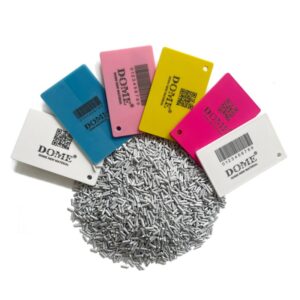
Selecting the Right Additive
Choosing the appropriate laser marking additive requires careful consideration of several factors:
Material Type:
Different materials absorb and react to laser energy in unique ways. For instance, plastics, silicone, and metals each require tailored additives. Common plastics like PP, PE, and ABS have specialized additives designed to enhance laser absorption, heat retention, and carbonization, ensuring clear markings. For softer materials like silicone, which have unique chemical properties, additives that improve laser sensitivity and compatibility are essential.
Marking Requirements:
The desired marking effect also dictates the choice of additive. For high-contrast “white-on-black” markings, additives that promote efficient carbonization under laser exposure are ideal. Conversely, for “black-on-white” or lighter markings, additives that induce foaming reactions to create fine bubbles are more suitable. Additionally, factors like color vibrancy, durability, and long-term fade resistance influence additive selection. For example, vibrant and fade-resistant markings require additives with strong color stability and excellent performance.
Production Process:
The manufacturing process also plays a crucial role. For injection molding, laser marking masterbatches are often preferred for better dispersion and uniformity. In contrast, powder additives may be more suitable for granulation processes, though attention must be paid to potential issues like uneven dispersion or sedimentation. Furthermore, the type of laser marking machine (e.g., UV or infrared) affects additive compatibility. Choosing additives that match the laser type ensures optimal marking quality and efficiency.
Controlling the Additive Dosage
The amount of additive used is critical to achieving desired results while balancing cost and performance. Generally, the recommended dosage for laser marking additives powder ranges from 0.2% to 0.5%, while laser marking masterbatches are typically added at 1% to 4%. However, this range may vary depending on the specific additive, material, and marking requirements.
Underuse:
Insufficient additive amounts may result in poor laser energy absorption and conversion, leading to unclear, faint, or blurred markings. This compromises marking quality and fails to meet expectations.
Overuse:
Excessive additive amounts not only increase costs but may also negatively impact the material’s physical and mechanical properties. For example, overuse can lead to excessive carbonization, uneven foaming, or degraded material performance, such as reduced toughness. This diminishes both marking quality and product performance.
For instance, when marking a plastic product, using the correct amount of additive ensures clear, durable, and visually appealing markings. However, excessive additive use may increase costs, reduce material flexibility, and cause defects like scorching or uneven coloration. Therefore, it is crucial to follow the additive’s instructions, consider material characteristics, and align with specific marking requirements to precisely control dosage and ensure efficient, high-quality results.
Safety Considerations During Use
Ensuring safety for both operators and the environment is paramount when using laser marking additives:
Personal Protection:
Laser marking additives often contain chemical components that may be irritating or hazardous. Operators should wear proper protective gear, such as safety goggles or dark-tinted glasses, to shield their eyes from harmful UV and infrared radiation emitted during marking. Protective clothing and gloves should also be used to prevent contact with additive powders or vapors, which could harm skin or eyes.
Workplace Safety:
Measures should be taken to minimize UV radiation and reflections in the workspace. For example, painting walls with dark colors can reduce radiation impact, and installing protective screens or curtains can limit the spread of UV radiation. Damaged protective equipment, such as scratched goggles or worn-out lenses, should be replaced immediately to maintain effective protection.
Environmental Protection:
Other personnel in the workspace should avoid directly observing the laser arc or flames during marking to prevent injury. Used additive packaging and leftover materials must be disposed of properly to avoid environmental pollution. Follow local environmental regulations for proper classification, storage, and recycling, ensuring compliance and sustainability. This approach not only protects the health and safety of operators but also helps preserve the surrounding environment.
By adhering to these guidelines, laser marking additives can be used effectively and safely, ensuring high-quality results while minimizing risks to people and the environment.
Future Prospects of Laser Marking Additives
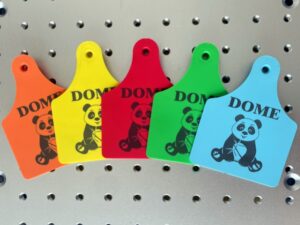
Continuous Technological Innovation
With the advancement of technology, laser marking additives are undergoing remarkable innovations in composition and performance:
Innovative Compositions:
New chemical compounds are increasingly being applied to the development of laser marking additives. For example, a patent by Jiangsu Boyun Plastic Co., Ltd. introduces the use of organophosphorus compounds as infrared absorbers for nylon laser marking. These compounds enhance the clarity and contrast of nylon markings without altering its base color, showcasing new possibilities for organophosphorus compounds. This trend suggests that more unique compounds with specialized properties may become key components in laser marking additives.
Similarly, materials like copper phosphate hydroxide are gaining attention due to their strong absorption in the near-infrared spectrum, excellent thermal stability, noticeable color changes, eco-friendliness, compatibility, and cost-effectiveness. Such materials are expected to see broader applications in the future as researchers continue to uncover and utilize compounds with superior multifunctional properties.
Enhanced Performance:
The absorption capabilities of laser marking additives are expected to improve further, allowing them to efficiently absorb laser energy across various wavelengths. This will enable better energy conversion into heat, resulting in improved marking quality for a wide range of materials and diverse marking requirements. Additionally, the compatibility of additives with different laser types will continue to be optimized. Whether for UV lasers, infrared lasers, or other advanced laser equipment, future additives will be designed to perfectly match these technologies, expanding the scope of laser marking applications.
These innovations will have profound impacts on industrial marking. On one hand, materials that were previously difficult to mark with high quality—such as high-hardness, high-toughness, or specialty materials—can achieve clear and durable markings with the help of new additives. This is particularly significant for industries like aerospace and precision manufacturing, where component traceability and quality control are critical. On the other hand, improved additive performance will significantly enhance marking speed, making the laser marking process more efficient in large-scale industrial production. This reduces production costs and helps businesses gain a competitive edge, driving the industrial marking field toward greater precision, efficiency, and sustainability.
Role in Industry Development
Laser marking additives are poised to play an increasingly pivotal role in the future development of various industries, demonstrating vast application potential.
Automotive Manufacturing:
As the automotive industry moves toward greater intelligence, lightweight designs, and customization, the demand for high-quality component markings is rising. Beyond standard serial numbers and production dates, more complex and precise markings—such as sensor parameters and smart module codes—are required for specialized parts. Laser marking additives ensure these markings remain clear and durable even in harsh environments involving high temperatures, vibrations, and corrosion. This facilitates efficient assembly management during production and supports subsequent maintenance, repair, and quality traceability, enabling the automotive industry to achieve higher levels of production efficiency and service quality.
Electronics and Appliances:
The electronics industry relies heavily on laser marking additives. As electronics evolve rapidly and product designs become more personalized and differentiated, high-quality laser markings are essential for branding, model identification, and certification labels on device casings. Laser marking additives enable finer, more aesthetically pleasing, and durable markings, while also supporting high-speed marking to meet the demands of fast-paced production lines. This enhances the overall market competitiveness of electronic products and helps manufacturers cater to consumers’ diverse needs.
PVC Pipe Industry:
In the PVC pipe industry, laser marking additives ensure clear and precise markings for critical information such as specifications and production numbers. These markings are essential for accurate installation in construction and municipal engineering projects, as well as for quality supervision and traceability. As the industry continues to improve its quality traceability systems, laser marking additives will play a key role in enabling accurate and efficient markings, improving coordination across the entire supply chain.
Livestock Industry:
Laser marking additives are also applied in the production of TPU livestock ear tags and other identification tools. These Laser additives ensure that markings remain clear and durable, supporting precise livestock management, disease prevention, and traceability of meat products. This contributes to the modernization and standardization of livestock farming practices.
In summary, laser marking additives act as the “finishing touch” in industrial production, enhancing marking quality and efficiency across various industries. As industries continue to advance, the application prospects of these additives will only grow, becoming a vital force in driving high-quality development across sectors.
Recommended Laser Marking Additives by Shenzhen Dome Materials Co., Ltd.

Comprehensive Range of Laser Marking Additives for Various Plastics
Shenzhen Dome Materials Co., Ltd. excels in the field of laser marking additives, offering a full range of products tailored for various types of plastics. From common plastics such as PP, PE, and PVC to engineering and thermoplastic materials like ABS, TPU, and TPE, Dome Materials provides specialized additives to meet diverse needs.
For example, in PP plastic laser marking applications, their additives significantly enhance the material’s laser absorption. Through precise formulation, these additives promote localized resin carbonization during laser exposure, achieving a clear “white-on-black” marking effect. This makes them ideal for products like PP plastic pipes and containers, where marking serial numbers, specifications, or other details is essential.
For ABS plastics, Dome Materials’ laser marking additives blend seamlessly with ABS raw materials, overcoming the material’s limited laser absorption and reaction capabilities. This enables high-quality markings on ABS components, such as electronic device housings. The resulting markings—whether intricate patterns, text, product models, batch numbers, or company logos—are sharp, smooth, and vividly colored, helping manufacturers in the electronics industry enhance both the precision and efficiency of their laser marking processes.
Moreover, Dome Materials’ laser marking additives support a wide range of marking effects, including “white-on-black,” “black-on-white,” “black-on-gold,” and even colorful designs on black surfaces. This versatility addresses the diverse requirements of industries for color and clarity in laser markings, providing reliable solutions for precise identification in manufacturing, packaging, livestock management, and more.
Expertise in Materials, Applications, and Customization
With extensive experience in plastic laser marking, Shenzhen Dome Materials Co., Ltd. offers professional technical support and customization capabilities to address the unique challenges of different materials and applications.
Automotive Industry:
Plastic components are widely used in various automotive parts, including engine components, interior elements (e.g., steering wheels, dashboards, buttons, and door handles), and more. These parts often require detailed markings, such as serial numbers, production dates, barcodes, QR codes, brand names, logos, and part-specific identifiers. Dome Materials leverages its expertise to recommend and guide the use of suitable laser marking additives for different plastic materials, ensuring that markings remain clear and durable even under harsh conditions like high temperatures, vibrations, and corrosion. This supports efficient assembly management, maintenance, and quality traceability throughout the automotive production process.
Electronics and Appliances:
As the electronics industry evolves rapidly, product designs increasingly emphasize personalization and differentiation. High-quality laser markings—such as brand logos, product models, and certification marks—are critical for electronic device housings. Dome Materials provides precisely matched laser marking additives for various materials like ABS and PC, along with professional technical support. They assist manufacturers in adjusting additive dosages, optimizing marking parameters, and refining processes to achieve fine, aesthetically pleasing, and durable markings. This ensures compatibility with fast-paced production lines, enhancing product competitiveness in the market.
Customization Capabilities:
Dome Materials also offers robust customization services. For clients with unique marking requirements—such as achieving specific color effects on particular materials or creating custom patterns or text formats—their expert R&D team can develop tailored laser marking solutions to meet individual needs.

